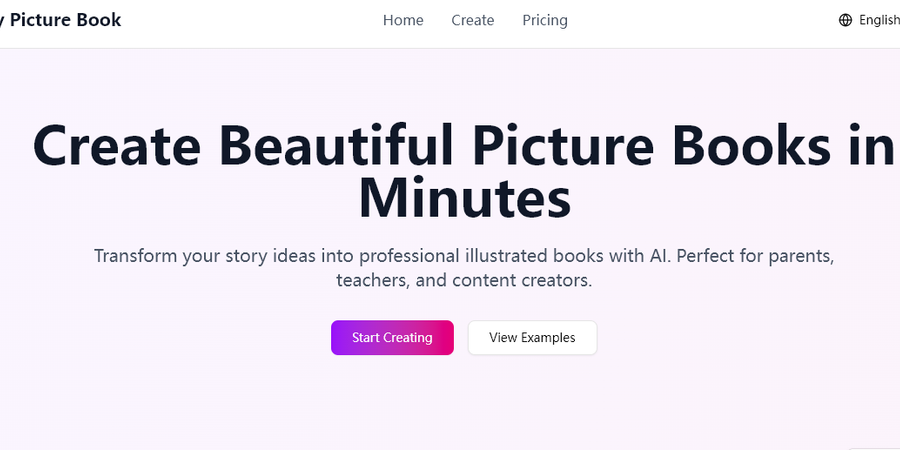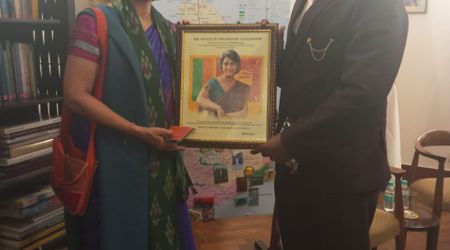Remember the last time you tried to draw a simple stick figure for a child's story? If you're like most people, the result probably looked more like abstract art than anything recognizable. Yet, we all have stories to tell – tales that could captivate young minds and spark imagination. The gap between having a great story and creating a visually appealing children's book has traditionally been enormous, requiring artistic skills that take years to develop.
This challenge has persisted for generations. Parents wanting to create personalized bedtime stories for their children, teachers developing custom educational content, and aspiring authors with limited artistic abilities have all faced the same frustrating barrier. The tools available were either too complex for beginners or produced results that looked amateurish at best.
The Evolution of Creative Tools
The landscape of creative technology has shifted dramatically in recent years. What once required a team of professional illustrators, editors, and designers can now be accomplished by individuals with nothing more than a story idea and access to the right tools. This democratization of creativity isn't just about convenience – it's about unlocking human potential that was previously constrained by technical limitations. Modern AI picture book generators exemplify this transformation, making professional-quality illustrated storytelling accessible to anyone.
Consider how photography evolved from requiring darkrooms and chemical knowledge to becoming accessible through smartphones. Similarly, the creation of illustrated content is undergoing its own transformation. The difference lies in the sophistication of modern AI systems that can understand narrative context, maintain visual consistency, and produce professional-quality results.
Understanding the Technical Challenge
Creating a coherent picture book involves several complex tasks that humans perform intuitively but computers have traditionally struggled with. First, there's story analysis – understanding the narrative arc, identifying key scenes, and determining how to break a continuous story into discrete, illustrated moments. Then comes the visual challenge of maintaining character consistency across multiple images, ensuring that the main character looks the same from page one to the final illustration.
Traditional text-to-image generators treat each request independently, often producing wildly different interpretations of the same character. This inconsistency makes them unsuitable for sequential storytelling. The breakthrough came with the development of context-aware image generation systems that can reference previous illustrations while creating new ones.
The Human Element in Automated Creation
Despite the technological sophistication involved, the most successful AI-powered creative tools maintain a strong focus on human input and control. The best results come not from fully automated systems, but from platforms that amplify human creativity rather than replace it. Users still provide the story, choose the artistic style, and make creative decisions about pacing and presentation.
This collaborative approach between human creativity and machine capability produces results that neither could achieve alone. The AI handles the technical execution – analyzing story structure, generating consistent illustrations, and managing the complex details of visual production. Meanwhile, humans contribute the emotional intelligence, cultural context, and creative vision that make stories truly engaging. Platforms like Any Picture Book demonstrate this balance perfectly, allowing users to maintain creative control while leveraging sophisticated AI capabilities.
Practical Applications Beyond Entertainment
While children's picture books might seem like a niche application, the underlying technology has broader implications. Educational institutions are using similar tools to create custom learning materials that reflect their students' backgrounds and interests. Therapists working with children can quickly generate visual aids for social stories and behavioral interventions. Marketing professionals create engaging visual content for family-oriented campaigns.
The speed of creation is particularly valuable in educational settings, where teachers often need to adapt materials quickly based on current events or student interests. A teacher can transform a news story into an age-appropriate illustrated narrative in minutes rather than hours or days.
Looking Forward: The Future of Accessible Creativity
As these tools become more sophisticated and accessible, we're likely to see an explosion of personalized content creation. Children might grow up in a world where every bedtime story is unique, tailored to their interests and featuring characters that look like them and their friends. The barrier between having an idea and sharing it visually continues to lower.
The implications extend beyond individual creativity to cultural preservation and representation. Communities can more easily create and share stories that reflect their values and experiences, contributing to a more diverse landscape of children's literature.
However, this technological advancement also raises important questions about the value of traditional artistic skills and the role of human creativity in an increasingly automated world. The most promising path forward seems to involve tools that enhance rather than replace human creativity, maintaining the irreplaceable human elements of storytelling while removing technical barriers.
Conclusion
The transformation of children's book creation through AI represents more than just a technological advancement – it's a democratization of storytelling that puts creative power into the hands of anyone with a story to tell. As these tools continue to evolve, they promise to unlock countless untold stories and give voice to perspectives that might otherwise remain unheard. Whether you're a parent wanting to create personalized bedtime stories or an educator developing custom learning materials, modern AI storytelling tools are making the impossible possible.
The future of storytelling isn't about replacing human creativity with artificial intelligence, but about removing the barriers that prevent great stories from being shared. In a world where anyone can become a published author and illustrator, the only limit is imagination itself.
The Bolgatty Palace rests on the beautiful Bolgatty Island in Kochi, Kerala, representing the grandeur of India's colonial past and architectural heritage. This historic mansion is renowned as one of the oldest surviving Dutch palaces outside the Netherlands. Built in 1744 by the Dutch traders to be the Governor's residence of the commander of Dutch Malabar, the palace stands today as a crown jewel in history. Today, it has been transformed into the Bolgatty Palace Island Resort, a luxu...
Chandni Chowk is one of India's most iconic and historic markets right in the heart of Old Delhi, where history meets vibrant energy. The soul of this area is defined by narrow streets teeming with people, the sizzling aroma of street food in the air, and countless shops overflowing with fabrics, jewellery, and spices. Walking through Chandni Chowk seems as though one is entering a time capsule. Mughal-era architecture's old-world appeal fits perfectly with the modern-day rush of pedest...
Tucked away along the historic stretch of National Highway 1, the Guru Tegh Bahadur Memorial is not your typical tourist spot; it’s a place that quietly stirs your thoughts. Unlike the bustling markets and loud monuments of Delhi, this memorial speaks in silence. It tells the story of a man who gave his life not for power or land but for the freedom of faith. Guru Tegh Bahadur, the ninth Sikh Guru, made the ultimate sacrifice to protect the rights of others, and this space captures that...
Have you ever come across a location that seemed to be sharing tales of ages past? Nestled in the serene Himachal Pradesh highlands, Ashapuri Mata Temple is a long-forgotten gem that echoes with ageless chants and is surrounded by breathtaking scenery. Even though the temple is half demolished, pilgrims and visitors seeking peace and harmony are nevertheless drawn to it by its beautiful surroundings and devotion to Maa Ashapuri, the goddess who is claimed to grant wishes. Echoes...
You know those rare places that somehow manage to slow down time the moment you step in? Majnu Ka Tilla is one of them. It’s not just a spot on Delhi’s map; it’s a living, breathing memory wrapped in prayer flags, dumpling steam, and stories passed down like lullabies. One minute, you're dodging autos and Delhi heat; the next, you’re wandering quiet lanes lined with Tibetan cafés, monks in maroon robes, and shopkeepers who smile like they already know you're going to fall in love with t...
Tucked away in the heart of Shimla, just off the bustling Ridge, lies a marketplace that feels like a page out of history—Lakkar Bazaar. With the aroma of fresh street food in the air, the clatter of wooden crafts, and the soft crunch of footsteps on cobbled paths, this charming bazaar is where the soul of old Shimla still thrives. Known for its intricate wooden handicrafts, warm local hospitality, and postcard-worthy Himalayan views, Lakkar Bazaar isn’t just a place to shop—it’s a plac...
At the far end of the Parvati Valley in Himachal Pradesh lies Tosh Village, a quiet mountain settlement surrounded by towering deodars and snow-tipped peaks. It’s a place where the air is crisp, the skies feel expansive, and the pace of life follows the rhythm of the hills. Even though the village is at an altitude as high as 2,400 metres, Tosh continues to be the last motorable village in the valley. With its laid-back charm, rustic wooden houses, and panoramic views of Tosh Gla...
In the golden heart of Jaisalmer, Salim Singh ki Haveli stands tall—a structure of ambition, artistry, and political defiance. Often called the Ship of the Desert for its prow-shaped design, the haveli is famed for its peacock-like roof, 38 uniquely carved balconies, and a history as dramatic as its silhouette. Unlike most havelis in the region, which were built for wealth display or noble leisure, Salim Singh ki Haveli was constructed to challenge authority. Its very existence was mean...
Tucked high in the Himalayas at an altitude of 4,270 metres, Hampta Pass gives its visitors an unparalleled experience through dramatically changing views. In just a span of a few days, it takes you from grassy meadows carpeted with flowers to stark, towering snowy mountains. This natural corridor connects the lush green valleys of Kullu with the dry and rocky landscapes of Lahaul and...
In the bustling heart of Delhi, surrounded by traffic and modern architecture, there stands Purana Qila, or “Old Fort.” Although it's famously linked to the Mughal period, archaeologists suggest that humans were settled here as early as 1000 BCE. This fort has seen emperors rise and fall, wars break out, and refugees take shelter, and today, people come in search of calm or maybe just a place to click the perfect sunset photo. From Myth to Mughal to Modern India Long befor...
Har Ki Pauri, or "Steps of the Lord," is a ghat in the heart of Haridwar, Uttarakhand, that houses centuries of faith within its stone steps. It is one of the most revered locations in Hinduism, located on the banks of the river Ganges. Pilgrims travel from across India and beyond to take a dip here, believing the river’s waters can cleanse sins and renew the soul. Amid the gentle sound of temple bells, the faint scent of incense, and the steady flow of the Ganga, Har Ki Pauri becomes t...
Jaipur’s celestial masterpiece, Jantar Mantar, was built in the early 18th century. This UNESCO World Heritage site is not just an observatory but a testament to India’s extraordinary astronomical prowess. Home to 19 massive instruments, including the world’s largest stone sundial, Jantar Mantar offers a fascinating glimpse into how ancient scholars decoded the cosmos. More than just a historical landmark, it’s a living marvel where the mysteries of the universe meet Rajasthan’s rich cu...
Kalkaji Temple, a sanctuary of deep spiritual energy, is located in South Delhi , where the city’s modern pulse meets ancient rhythms. It’s not just a place of worship; it’s an experience. For instance, have you ever wandered into a place and felt its energy pulling you in? Kalkaji Temple radiates that kind of energy. This temple is dedicated to an incarnation of the fierce and pr...
Ever fantasised about getting lost in a land where snow-covered mountains reach the heavens, rivers sing ancient lullabies, and forests become the earth's whispered secrets? That's Parvati Valley for you—a mystic sojourn in Himachal Pradesh where spirituality and nature go hand in hand. But what really sets Parvati Valley apart is its combination of raw Himalayan splendour and deep-seated spiritual power. From hiking and hot springs to ancient temples and yoga retreats, every move here...
The Beatles Ashram, or Chaurasi Kutia, is not just a spiritual retreat—it’s where global pop culture met ancient Indian wisdom. In 1968, The Beatles stayed here to learn Transcendental Meditation, leading to a creative explosion that gave birth to nearly 40 songs. Today, this abandoned-yet-alive ashram stands as a timeless symbol of inner peace, artistic rebirth, and East-West cultural fusion. Where Music Met Meditation: The Legacy of the Beatles Ashram The Beatles Ashram...
Nestled in the lap of a mountain on the banks of the Beas River, along the Mandi-Manali national highway, the Hanogi Mata Temple is a highly esteemed place of worship. Known locally as the Saraswati Mata temple, it honours Hanogi Mata, an incarnation of Goddess Saraswati. Some people also associate the temple with Maa Durga. This reflects the dual essence of Durga’s power and strength, and Saraswati’s grace and wisdom. The culmination of divine energy mixed with the breathtaking scenery...
The Telangana Rising Global Summit 2025, held at Bharat Future City, Hyderabad on December 8–9, witnessed the esteemed participation of Her Excellency Mahishini Colonne, Ambassador of Sri Lanka to India. Her presence added remarkable diplomatic value to the international gathering, which brought together delegates from over 40 countries. Her Excellency appreciated Telangana’s long-term development vision under Telangana Rising 2047, especially its focus on technology, women empowerment,...
The Telangana Rising Global Summit 2025, held at Bharat Future City, Hyderabad on December 8–9, witnessed the distinguished presence of His Excellency, Dr. Shankar Prasad Sharma, Ambassador of Nepal to India. His participation marked a significant moment in India–Nepal diplomatic engagement and regional cooperation. His Excellency appreciated Telangana’s vision under Telangana Rising 2047, especially its focus on tourism, sustainable development, skill empowerment, entrepreneurship, and...
Panna Meena Ka Kund is a hidden wonder that waits quietly in the shadow of Amer Fort, just outside Jaipur. While Amer Fort attracts crowds with its royal halls and battlements, this stepwell feels like a secret treasure tucked away behind yellow sandstone walls. Walk up to it in the early morning, and you’ll see how the sun paints perfect patterns across the zigzag steps. The steps look like a puzzle carved into the earth, and the still water below mirrors the sky. More than just...
Amid the grandeur of Humayun’s Tomb complex in Delhi, there lies a lesser-known but historically rich monument: Isa Khan’s Tomb. Often overshadowed by its more famous neighbour, this tomb actually predates Humayun’s and showcases the architectural prowess of the Lodhi era. Built in the mid-16th century, this tomb is among the rare surviving structures from the Sur dynasty in India. What makes it truly remarkable is its octagonal design, a rarity for its time, and its proximity to Mughal...
Old Delhi is a street food lover’s dream, where every alley, every corner, and every vendor tells a story of tradition, flavour, and irresistible aromas. The air is thick with the scent of sizzling kebabs, crispy paranthas, and sweet, syrupy delights that have been perfected over centuries. Here, food isn’t just a meal but an experience, an explosion of taste, spice, and culture packed into one unforgettable bite. Whether you're a local or a visitor, Old Delhi’s street food scene is an...
The Char Dham Yatra is a sacred Hindu pilgrimage that covers four revered sites in Uttarakhand: Yamunotri, Gangotri, Kedarnath, and Badrinath. It is believed that undertaking this journey cleanses sins and paves the way for salvation ( moksha ). The trek begins at Yamunotri, the source of the Yamuna River, and continues to Gangotri, the origin of the Ganges. Kedarnath is home to one of Lord Shiva’s twelve Jyotirlingas, while Badrinath is dedicated to Lord Vishnu. Traditionall...
Kuldhara Village is shrouded in mystery and silence. This village, located near Jaisalmer in Rajasthan, was originally inhabited by the wealthy Paliwal Brahmins. But one tragic night, the entire village vanished, leaving just vacant houses and unsolved mysteries. Some claim they fled to avoid high taxes, while others believe a cursed love story sealed their fate. Today, Kuldhara is a ghost village with shattered walls and lonely pathways that hold secrets from the past. Visitors report...
Kerala’s rich history finds its heart in Fort Kochi, a coastal gem that embodies the state’s cultural essence and remains a must-visit for every traveller. This historic town is a testament to Kerala’s lively past, with Fort Immanuel—built in 1553—marking India’s first European fort. Wandering through its streets is like stepping into a living museum, where Portuguese, Dutch, and British influences blend seamlessly, reflected in architectural marvels like St. Francis Church and the Dutc...
Nestled in the historic quarters of Fort Kochi, St. Francis Church is a silent witness to centuries of colonial rule, maritime exploration, and cultural exchanges. Built in 1503, it is the oldest European-built church in India and played a pivotal role in shaping the religious and architectural landscape of the region. A significant marker of history, the church is also known as the original burial site of Vasco da Gama, the Portuguese explorer who discovered the sea route to India. Des...
Perched atop serene hills in Tripunithura, Kochi, the Hill Palace Museum stands as Kerala’s first heritage museum and the largest archaeological museum in the state. Once the royal residence of the Maharajas of Cochin, this grand palace has been transformed into an ethno-archaeological museum, offering a fascinating journey through time. Set across 52 acres of lush greenery, the museum houses rare manuscripts, ancient sculptures, royal artefacts, and a botanical garden—a treasure trove...
Mr. M.D. Naidu, Founder & CEO of Pracharam Media and Organiser of the Stree Shakti Pratibha Awards 2025, met and felicitated Dr. Kadiyam Kavya garu today in New Delhi during a warm and inspiring interaction. During the meeting, Mr. Naidu honoured Dr. Kavya garu with a traditional shawl and presented a specially crafted digital portrait, appreciating her impactful contributions as a youth inspiration, public influencer, and strong advocate for women empowerment. Mr. Naidu also...
In a significant diplomatic engagement today, MD Naidu, Founder & Visionary of the Stree Shakti Pratibha Awards , met His Excellency Dr. Shankar Prasad Sharma, Ambassador of Nepal to India, at the Embassy of Nepal, New Delhi. During the 20-minute discussion, MD Naidu extended an official invitation for Nepal’s participation in the Stree Shakti Pratibha Awards 2025 . The Ambassador warmly welcomed the initiative and confirmed that Nepal will have definite representation a...
Mr. M.D. Naidu, Founder & CEO of Pracharam Media and Organiser of the Stree Shakti Pratibha Awards 2025, attended a special cultural evening hosted by Her Excellency Mahishini Colonne, High Commissioner of Sri Lanka to India, at the Sri Lanka Residence in Chanakyapuri, New Delhi. The event celebrated the launch of the unique travelogue, “Around the World in Magnets – Sri Lanka”, authored by Dr. Anthony Vipin Das and Ms. Vidushi Duggal, featuring an insightful conversation moderated...
Keerthi Foundation, a leading rehabilitation and de-addiction centre in Chennai, today announced the expansion of its treatment programs aimed at addressing alcohol dependency, drug addiction, and behavioural health issues. The organisation has strengthened its clinical, counselling, and wellness services to meet the increasing demand for structured recovery support in Tamil Nadu. India has witnessed a significant rise in substance-use disorders over the past decade, and metropolitan ci...
Aryan Hitec Waterproofing Pvt Ltd, one of the region’s fastest-growing specialists in structural protection and leakage prevention, today announced the expansion of its service capabilities to meet the increasing demand for waterproofing in Chennai. With rising infrastructure development, homeowners, builders, and commercial property owners are seeking reliable and long-lasting solutions to protect their structures from water damage. For over a decade, Aryan Hitec Waterproofing Pvt Ltd...
The recent bomb blast that has shaken the nation is a dark and painful tragedy that has left every Indian citizen in deep sorrow. At a time when India is progressing with unity, development, and global recognition, such acts of terror attempt to break the peace and harmony that define our nation. This attack has claimed innocent lives and caused unimaginable suffering to many families. MD Naidu, Founder & CEO of Pracharam Media and Chairman of the Stree Shakti Pratibha Awards, expre...
The organizing committee of the Stree Shakti Pratibha Awards – 2025 is proud to announce that noted costume designer, creative director, and film industry contributor Mrs. Pragathi Rishab Shetty has officially accepted the invitation to receive the “Stree Shakti Creative Excellence Award – 2025.” This honor celebrates her remarkable achievements in bringing authenticity, cultural depth, and aesthetic excellence to Indian cinema. As a creative professional who bridges art, tradition, and...
In an era dominated by fast-paced digital information, StorifyNews.com has established itself as a reliable and user-friendly online news aggregator, curating credible stories from trusted sources worldwide. The platform is designed to simplify news consumption by bringing the latest updates in politics, business, technology, entertainment, health, and global affairs — all in one place. Founded with a mission to make news accessible and unbiased, Storify News ensures readers stay inform...
Moblics Enterprises, one of India’s rapidly expanding electronics manufacturers, is redefining the LED lighting and PCB industry from its base in Aurangabad, Bihar. With a growing national footprint, an expanding distributor network, and an estimated revenue scale of ₹5–10 crore annually, Moblics is positioning itself as one of the fastest-growing regional electronics brands in North India. From Local Startup to Manufacturing Leader Founded in 2021 by Mrinal Kishor Mishra, Mobli...
Pracharam Media is honoured to announce that the Hon’ble President of India has graciously conveyed her greetings and best wishes to the Stree Shakti Pratibha Awards 2025 , scheduled for 21st and 22nd November at Mallareddy University, Hyderabad. In an official communication from Rashtrapati Bhavan, the Hon’ble President expressed appreciation for the initiative and extended her warm wishes for the success of the programme celebrating women achievers. The correspondence further me...




































